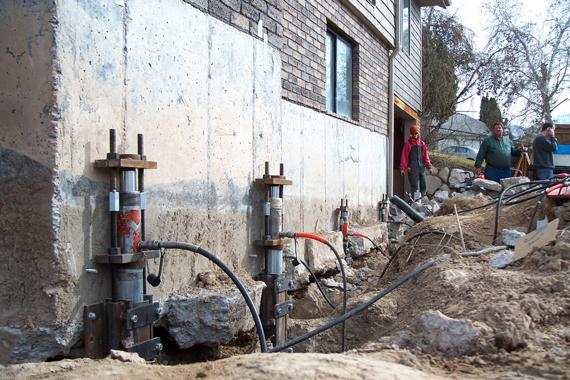What Kind Of Cement To Use For Foundation Repair?
In addition to causing water to pour into the basement, excessive movement can damage the foundation, making it less able to support the remainder of the building. A home or other building owner’s worst fear is a cracked foundation. Given how challenging it may be to correct a foundation issue, it’s also not very pleasant for the waterproofing contractor. You need to figure out what caused the fissures.
Depending on whether the foundation cracks threaten the integrity of the structure or not, there are many repair techniques. Whether water is actively seeping through the gaps or not, there are also distinct issues. It’s in a building owner’s best interests to get foundation cracks repaired as soon as possible, regardless of the resolution to any of those questions.
Is This Foundation Crack Hazardous or Normal?
If you are unclear about the size of your foundation cracks, keep an eye on them. Simply mark off and date each crack’s ends using a pencil. After some time has passed, you will be able to determine if the fracture is the result of natural settling or whether it points to a more serious issue.
Following them will also assist foundation repair professionals in figuring out how the cracks developed and the best method to repair them.
The Ineffectiveness of Crack Repairs
Cracks, especially active horizontal or stair-step cracks, will only deteriorate with time, grow more hazardous, and cost more to repair in the long term. The Internet is flooded with how-to articles for do-it-yourself crack repair, and many large box retailers provide these services.
Repairing cracks in basement walls is a type of foundation repair that should not be attempted on your own. Errors can occur, and the proper remedy may not have been administered by your particular wall fissures.
Epoxy injections, sealants, caulk, patches, and other “cover-ups” are temporary fixes for basement wall cracks. Because they don’t deal with the dirt that is causing the foundation to fracture, these fixes are merely band-aids that temporarily cover the issue.
Kind Of Cement Used For Foundation Repair
To fix frequent issues with concrete foundations, all-purpose cement is employed. But you should use hydraulic cement, to repair water damage to your foundation. Sadly, cement cannot always be used to repair fractures in concrete foundations. nonetheless, before employing, find out what damages your foundation and repair it accordingly.
How To Repair Foundation With The Help Of Cement?
Check your foundation right away for any cracks that require fixing. The quicker cracks are repaired before they spread, the simpler and less expensive the repairs will be.
Look For Cracks In Your Foundation
The foundation’s surrounding earth sinks with time. Since concrete expands and contracts in response to temperature variations, water can start to seep through the foundation walls. The pressure from these causes weakens the concrete of the foundation, and if cracks appear, they frequently spread further and may become a serious issue if left unattended.
Depending on how much the earth has moved, settling soil typically results in horizontal fissures, which can be narrow or broad. The most frequent cause of foundation cracking is often this.
Excessive dampness near the foundation is the second most typical reason for this problem. Too much moisture can cause difficulties by allowing water to seep through the concrete and into your basement from the other side. Concrete cracks caused by the expansion and contraction of the foundation are often vertical or diagonal and hairline thin. As long as they are repaired right once and are not let develop or expand, they are less of a concern than cracks brought on by settling or moisture intrusion.
Remove The Dust And Any Loose Concrete
A strong scrub brush should be used to remove dust and loose concrete from the collapsing region. Using a chisel, hammer, or rotary hammer with a chisel top, remove bigger crumbling bits (save them for later). Keep undamaged concrete in place and only remove broken concrete. If there is exposed rebar, you must use a wire brush to scrub away any remaining rust before pressure washing the steel.
Mix And Fill Cracks
If the fracture extends through the concrete foundation, repair the damage on the exterior first, then repair the damage on the interior. Put three parts sand and one part cement in the bucket. As you mix the solution, add water.
Up until you get a thick mixture, keep adding water gradually. In the meantime, prepare a new batch of concrete with a different concentration. In the small bowl, mash some cement with some water. Up till the mixture resembles paint in consistency, keep adding water.
Apply a coating of the cement that resembles paint to the interior of the fissure using a little paintbrush. Apply the mixture liberally to all of the crack’s interior surfaces. To place the heavy concrete mixture into the crack, use a putty knife. Put pressure on the mixture as you keep adding concrete to push it deep into the fissure.
Until the crack is filled with the thick concrete mixture, keep pouring additional concrete into it. The concrete patch’s surface may be levelled with any straight edge. Allow the concrete repair to air dry for one to two hours. Use a trowel to add a thin coating of cement to the patch’s surface once it has cured. Use a circular motion to apply the surface cement. The foundation’s surrounding surface and the surface cement must be level.
Seal The Foundation
Foundation plays a significant role in a home’s curb appeal, despite being a surface that endures a lot of harm from dangers. With a liquid sealer, you may seal new or old concrete and defend against things like acids, grease, oils, food, salt, and more.
This will help you maintain your newly poured investment. Depending on your desire, you can choose a satin finish or a semi-gloss shine. Using a brush, roller, or garden sprayer, coat the foundation with the sealer.
